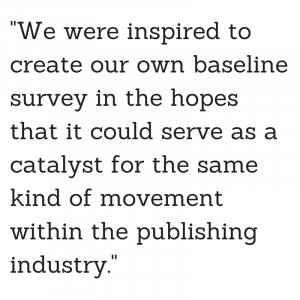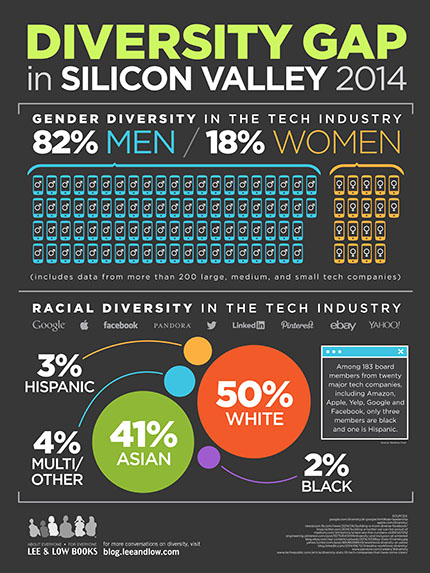 If you’ve been following us for a while, you know that over the past few years we’ve released a series of infographics about the diversity gap in different industries including publishing, film, television, theater, and politics. Our infographic studies were designed to give people who were unfamiliar with issues of race and gender a sense of how deep the diversity problem goes in the United States and how entrenched these issues are in every facet of media. Our latest infographic, The Diversity Gap in Silicon Valley, is our first study that reports on a bigger question: What comes after the numbers are established? Once we acknowledge the diversity gap, what can we do to close it?
If you’ve been following us for a while, you know that over the past few years we’ve released a series of infographics about the diversity gap in different industries including publishing, film, television, theater, and politics. Our infographic studies were designed to give people who were unfamiliar with issues of race and gender a sense of how deep the diversity problem goes in the United States and how entrenched these issues are in every facet of media. Our latest infographic, The Diversity Gap in Silicon Valley, is our first study that reports on a bigger question: What comes after the numbers are established? Once we acknowledge the diversity gap, what can we do to close it?
The tech industry presents a unique model for this. After Pinterest engineer Tracy Chou asked, “Where are our numbers?” hundreds of companies, both large and small, chose to release the diversity statistics of their staffs in a transparent way. Although the numbers showed a lack of diversity, after they were revealed there was a flurry of activity across the industry to address the problem. We were encouraged to see the brightest and the best minds in technology confronting a decades-old problem with pragmatism, budgets, and goals.
 Given this, we were inspired to create our own baseline survey in the hopes that it could serve as a catalyst for the same kind of movement within the publishing industry. The Diversity Baseline Survey we’ve proposed would be the first of its kind for US publishers. It involves creating statistics that do not yet exist by measuring staff diversity among publishers and review journals in four areas: gender, race, sexual orientation, and disability.
Given this, we were inspired to create our own baseline survey in the hopes that it could serve as a catalyst for the same kind of movement within the publishing industry. The Diversity Baseline Survey we’ve proposed would be the first of its kind for US publishers. It involves creating statistics that do not yet exist by measuring staff diversity among publishers and review journals in four areas: gender, race, sexual orientation, and disability.
There is precedence for a survey like this, not only from the tech industry, but also from the publishing industry in the United Kingdom. Both industries ran surveys as recently as 2014. Even large publishing houses, such as Hachette UK, HarperCollins, and Penguin Random House UK, were among the publishers who participated in the British survey. Hopefully, this is a good sign that these companies might extend their participation to the US version of the survey.
In the past, publishers have usually put the responsibility on readers for the lack of diverse representation in books. The extremely dated adage that “diverse books do not sell” has become a belief that has reached mythical proportions. While it’s important for readers to support diverse books with their dollars and voices, it’s equally important for publishers to self-reflect on how they can do better on their end. We must acknowledge that one factor contributing to the lack of diverse books is the lack of diversity among the people who edit, market, review, and sell the books. Surveying our staffs and reporting on our  findings would give us a starting point, not to point fingers or assign blame (especially since most media industries face similar problems) but to bring clarity to the problem so we can understand it better, attempt to correct it, and measure whether or not we are improving.
findings would give us a starting point, not to point fingers or assign blame (especially since most media industries face similar problems) but to bring clarity to the problem so we can understand it better, attempt to correct it, and measure whether or not we are improving.
Publishers, the onus is on us to move forward. Many publishers have said that they support We Need Diverse Books and the movement for more diverse books, but words are not the same as action. If we are serious about increasing the number and quality of diverse books, it is essential for us to be transparent about our own challenges. By surveying our staffs and sharing our numbers, we can work together to put in place sustainable programs that will increase diversity among publishing staffs in the long-term.
Here are some ways you can help:
Sign the petition. We consider transparency in the publishing industry both a social and economic justice cause. If you agree, stand up and be counted. Your name in support of this effort will be used to convince publishers to join this effort.
Place a comment in the comment field of School Library Journal’s article about the survey. Public commentary about this issue from educators, librarians, reviewers, editors, authors, and illustrators helps put a face to this problem. Many of the gatekeepers/decision makers do not understand the problem, but words can make a difference and change people’s minds.
Ask your publishers to sign on. If you are an author or illustrator, contact your editors and other publishing contacts and encourage them to participate in the survey. Your voice in support of this effort can make a difference.
Subscribe to Lee & Low’s blog or social media channels. Understanding the issues is important, but the complexity surrounding issues of race and gender can be daunting. We discuss these issues on a daily basis. Learn through reading and engagement in a safe place to ask questions and stay current on the issues.









